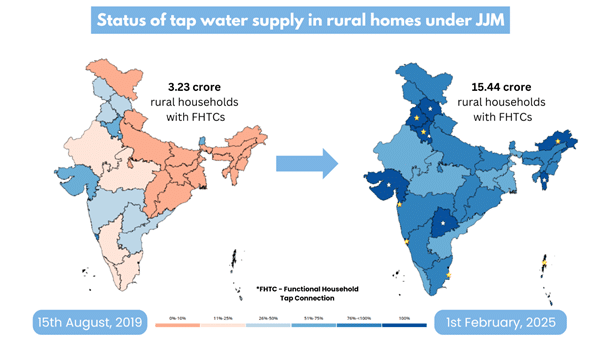Transforming Rural India: The Jal Jeevan Mission

The Jal Jeevan Mission (JJM) is a transformative initiative launched by Prime Minister Narendra Modi on August 15, 2019. As of February 1, 2025, the mission has successfully provided tap water connections to 12.20 crore additional rural households. This brings the total coverage to over 15.44 crore households, which accounts for 79.74% of all rural households in India. Before the mission began, only 3.23 crore rural households, or 17%, had access to tap water. This significant progress marks a crucial milestone in improving the quality of life for millions of people in rural areas.
The mission aims to free women and children from the centuries-old burden of fetching water. It seeks to enhance their health, education, and socio-economic conditions. By providing easy access to clean water, the Jal Jeevan Mission adds dignity and pride to rural families. The mission also emphasizes sustainable water management practices, including greywater management, water conservation, and rainwater harvesting. A community-driven approach is at the heart of JJM, encouraging widespread participation and awareness about water issues.
Progress Under the Jal Jeevan Mission
The Jal Jeevan Mission has made remarkable strides in its implementation. As of February 1, 2025, 15.44 crore rural households have received tap water connections. This achievement is a testament to the mission’s effectiveness and the commitment of various stakeholders involved. The Har Ghar Jal initiative has reported progress in 189 districts, with 108 of them certified for supplying tap water to all households, schools, and Anganwadi centers.
At the block level, 1,862 blocks have reported progress, with 892 certified. The panchayat level shows even more impressive numbers, with 1,18,230 panchayats submitting reports and 79,402 achieving certification. In terms of villages, 2,51,579 have reported progress, and 1,53,193 have been certified. Notably, 11 states and Union Territories, including Goa, Haryana, and Telangana, have achieved 100% tap water connection coverage for all rural households.
Additionally, the mission has ensured that 9,32,440 schools and 9,69,585 Anganwadi centers now have a reliable supply of tap water. This comprehensive approach not only addresses water scarcity but also promotes better health and education outcomes for children and families in rural areas.
Objectives of the Jal Jeevan Mission
The Jal Jeevan Mission has several broad objectives aimed at improving water supply and management in rural India. One of the primary goals is to monitor the functionality of tap connections to ensure that all households have reliable access to water. The mission also promotes voluntary ownership among local communities, encouraging contributions in cash, kind, or labor to support water supply initiatives.
Sustainability is another key focus. The mission aims to ensure the long-term viability of water supply systems, including the maintenance of water sources and infrastructure. This involves securing funding for regular operations and maintenance. Furthermore, the Jal Jeevan Mission emphasizes the empowerment and development of human resources in the water sector. This includes training in construction, plumbing, electrical work, water quality management, and catchment protection.
By addressing these objectives, the Jal Jeevan Mission not only aims to provide tap water connections but also seeks to create a sustainable and community-driven approach to water management. This holistic strategy is essential for ensuring that rural households can rely on safe and clean drinking water for years to come.
Impact of the Jal Jeevan Mission
The impact of the Jal Jeevan Mission on rural life has been profound. Various national and international institutions have highlighted the mission’s benefits. The World Health Organization (WHO) estimates that achieving the goals of JJM will save over 5.5 crore hours daily, primarily for women who traditionally spend hours collecting water. This time savings can be redirected towards education, employment, and other productive activities.
Moreover, the WHO projects that ensuring safe drinking water for all households in India could prevent nearly 400,000 deaths from diarrheal diseases. This would save approximately 14 million Disability Adjusted Life Years (DALYs), significantly improving public health. Research by Nobel laureate Prof. Michael Kremer suggests that safe water coverage could reduce mortality among children under five by nearly 30%, potentially saving 136,000 lives annually.
The Indian Institute of Management Bangalore, in collaboration with the International Labour Organization (ILO), estimates that the Jal Jeevan Mission will generate 59.9 lakh person-years of direct employment during its capital expenditure phase. Additionally, the operation and maintenance phase could create 13.3 lakh person-years of direct employment. These figures underscore the mission’s potential to not only improve health outcomes but also stimulate economic growth and job creation in rural areas.
Observer Voice is the one stop site for National, International news, Sports, Editor’s Choice, Art/culture contents, Quotes and much more. We also cover historical contents. Historical contents includes World History, Indian History, and what happened today. The website also covers Entertainment across the India and World.
Follow Us on Twitter, Instagram, Facebook, & LinkedIn

